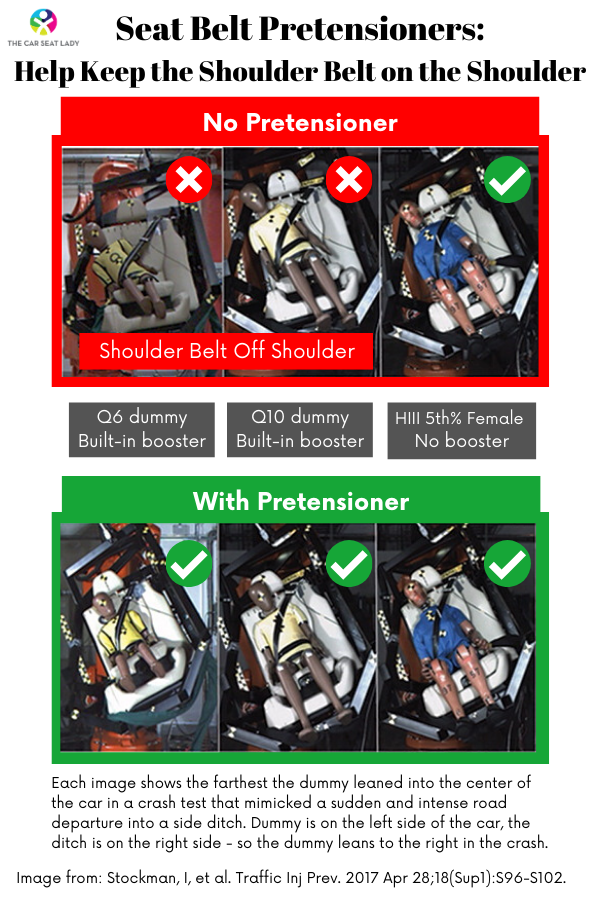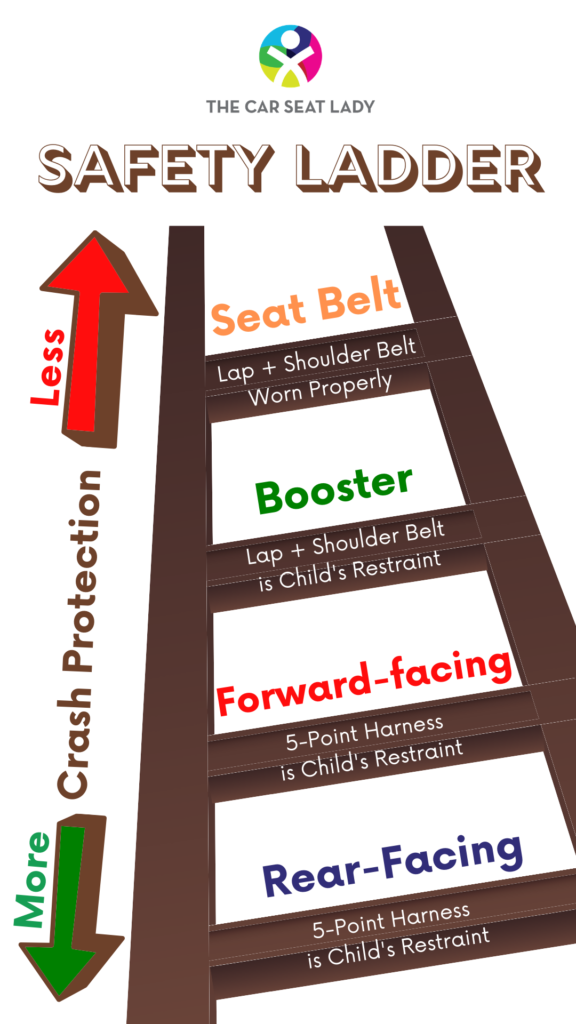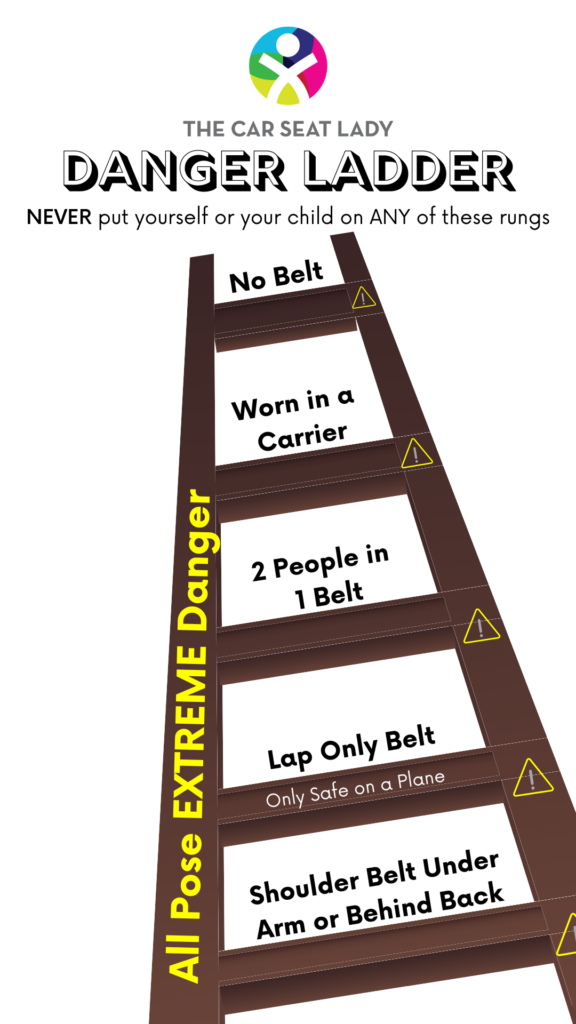On February 6, 2020, ProPublica published an article with the sensational title “Evenflo, Maker of the “Big Kid” Booster Seat, Put Profits Over Child Safety.” The article’s header contains a disturbing GIF of a child-sized crash test dummy lurching sideways out of a high-backed booster seat from a simulated car crash.
While much of what ProPublica reported is factually correct, the article omits a large quantity of additional evidence that complicates and desensationalizes the coverage. The fact is, booster seats and side-impact crashes (and car seat safety more broadly!) are extremely complex topics that shouldn’t be oversimplified toward alarming conclusions.
In this response, we will highlight the broader landscape of information that parents and car seat technicians need to know in evaluating vehicles and car seats. We at The Car Seat Lady attend the leading car seat safety research conferences (SAE, ACIP, PoCC, and more) each year, and insights from those conferences inform this piece. We also reached out to several leading researchers, who shared many of the resources linked below.
ProPublica devoted much of its article to criticizing the lack of a side-impact testing standard in the United States. However, a side-impact testing standard would only prevent 5.2 deaths and 64 injuries (MAIS 1-5) to children under 40 pounds each year, according to NHTSA. In addition, the proposed standard is for a near-side impact, not the far-side that ProPublica highlights.
A side-impact testing standard is simply not the most important policy change that ought to be made to keep children safer in cars. Instead, we urge the government to focus on other key mandates that would save more kids’ lives.
However, we realize that government change is often achieved slowly, and families are looking to keep their kids safe right now. Therefore, we’ve paired each of these “wish list” items for policy change with actionable steps that parents can take immediately to make the safest choices for their families.
Safety Priorities for Vehicles
Safety Priorities for Car Seats:
ProPublica highlighted the side-impact crash that left 5-year-old Jillian paralyzed and sent her 6-year-old sister to the hospital in critical condition with a broken pelvis. You can see Jillian’s booster seat in the back seat of her crumpled 2005 Suzuki Forenza – a vehicle which received the lowest rating – “poor” – in the Insurance Institute for Highway Safety’s side impact crash test. The roof is absent in this picture as the jaws of life were needed to extricate the girls.
Pretensioners immediately tighten your seat belt in the first milliseconds of a crash to help hold you in position. Automakers have known for decades that pretensioners enhance safety. That’s why most vehicles have had pretensioners in the front seats for decades – and all cars, SUVs, and minivans in the US have since 2008 – even though NHTSA has never required it. Pretensioners lower the risk of death by 12.8% compared to seat belts without pretensioners for those riding in the front seat of a car, compact SUVs, or minivans. This is why many vehicle owners’ manuals explain that pretensioners are there “for added protection”.
The most challenging crash type for a seat belt is a far-side impact – where your body is thrown to the opposite side of the car. This is the type of crash that ProPublica highlighted in both their Evenflo crash test footage and with Jillian’s story. I’m going to suggest, using the evidence below, that had the seat belts in Jillian’s car or the Evenflo crash test had pretensioners, the shoulder belt may not have slipped off the shoulder, and the body would have been kept upright and within the protection of the shoulder belt.
What’s the Evidence for Pretensioners?
Stockman, I, et al. Seat belt pre-pretensioner effect on child-sized dummies during run-off-road events. Traffic Inj Prev. 2017 Apr 28;18(Sup1):S96-S102.
Pretensioners keep the shoulder belt on the shoulder.
This study looked at whether a seat belt pretensioner is beneficial to children (6y & 10y dummy) & small adults (5th% female) in run-off-road events, which cause the body to lurch sideways – in much the same way as the body does in a far-side side impact. The dummies were seated on the left side of the car, and as the vehicle ran off the road on the right hand side, the dummy moved to the right (you always move towards the impact). Each dummy was crash tested twice – once with and once without a seat belt pretensioner. The study found that the use of a seat belt pretensioner reduced how far the dummies leaned to the side because the shoulder belt remained on the shoulder, which allowed it to support the side of the lower torso.

Tylko, S., et al. Responses of the Q6/Q6s ATD Positioned in Booster Seats in the Far-Side Seat Location of Side Impact Passenger Car and Sled Tests. Stapp Car Crash Journal. 2015 Nov;59:313-35.
Pretensioners were found to reduce lateral head displacements in all sled test configurations but the greatest reduction in lateral excursion was obtained with a high back booster seat secured with LATCH and tested in combination with pretensioners.
Seacrist, T., et al. Evaluation of Pediatric ATD Biofidelity as Compared to Child Volunteers in Low-Speed Far-Side Oblique and Lateral Impacts. Traffic Injury Prevention. 2014;15(sup1), S206–S214.
This study looked at two different types of dummies – Q6 and Q6s – and real kids to see how each moved in a low-speed far-side oblique and lateral impact. The study found that none of the dummies moved exactly like real kids did in a far-side impact. The dummies all leaned farther to the side than the real kids – possibly because of differences in the spine of a real child than a dummy. The shoulder belt was more likely to slip off the shoulder of the dummy than the real kids. Pretensioning had a greater effect on improving the movement of the dummy than the real kids – which could lead to overestimations of the benefit of the pretensioner for a real child.
These studies suggest that pretensioners can improve the protection to kids & adults in the rear seat:
https://crashstats.nhtsa.dot.gov/Api/Public/ViewPublication/811835
https://pubmed.ncbi.nlm.nih.gov/19026231
https://pubmed.ncbi.nlm.nih.gov/26660749
https://pubmed.ncbi.nlm.nih.gov/20544577
https://pubmed.ncbi.nlm.nih.gov/17563669
https://pubmed.ncbi.nlm.nih.gov/19746311
https://pubmed.ncbi.nlm.nih.gov/25307375
Crashworthiness means how well a vehicle can protect the people in it during a crash. In the US, the Insurance Institute for Highway Safety’s website is the best place to see how well a particular vehicle will protect its occupants. Vehicles that are safest will win a Top Safety Pick (TSP) or Top Safety Pick + (TSP+) from IIHS.
The Car Seat Lady has a Family Vehicle Buying Guide – and in order to make it into our guide the vehicle has to earn a TSP or TSP+. We’ll be updating it shortly for 2020 (IIHS will be releasing their first round of 2020 results in February 2020).
Crash prevention technology – often called autobrake, or autonomous emergency braking – is where the vehicle senses that you are too close to something and about to crash, and applies the brakes for you in the hopes of preventing the crash, or at the very least decreasing the speed at which the crash occurs. Autobrake isn’t perfect – but it is the best thing we have at preventing crashes from occurring.
The crash that left Jillian paralyzed occurred when Jillian’s mom turned left onto eastbound Route 25 and collided with a 2000 BMW headed westbound on Route 25. Crash prevention technology in Jillian’s Suzuki would not have prevented the crash – as currently it can only prevent frontal and rear impacts. HOWEVER, if the BMW that hit them had crash prevention technology it may have prevented the crash – as it was a frontal crash for the BMW when it plowed into the Suzuki’s side.
What’s the difference between forward collision warning (FCW) and automatic emergency braking (AEB)?
Both are activated when the vehicle senses that it is about to crash into something.
FCW simply warns the driver that a crash is about to happen – in the hopes of reminding the driver to brake hard and/or swerve.
AEB is where the vehicle takes over and brakes HARD.
An IIHS study of GM vehicles found that FCW reduced the number of front-to-rear crashes with injuries by 30%, and FCW + AEB reduced these crashes by 64%. An earlier study involving vehicles from 7 different manufacturers had similar findings – with a 20% and 57% reduction, respectively, in front-to-rear crashes with injuries with FCW vs FCW+AEB.
The take-away: Warning the driver helps avoid some crashes… but the best thing is for the car to take over the braking as the car’s reaction times are much faster than a human’s.
This recommendation applies if you’ll have kids in boosters or big kids/adults riding in the back seat.
In the US, very few vehicles feature pretensioners in the back seat. This may change in the next few years as the Insurance Institute for Highway Safety is developing a new crash test to evaluate the safety of the back seat – after finding that as the front seat has gotten safer, the back seat hasn’t kept up. This test will hopefully be out for the 2022 model year.
In 2015 EuroNCAP (European New Car Assessment Program – similar to our IIHS) introduced a new full frontal crash test featuring the 5th% female dummy, who happens to be the size of an average 12 year old, in the back seat. In order to do well in this test, most vehicle manufacturers found that they needed to put pretensioners and load limiters into their seat belts in the back seat. As a result, the majority of cars in Europe now feature pretensioners in the back seat.
After emailing with most of the major automakers, none could provide a list of their US vehicles that feature pretensioners… so I had to read each owners manual to see if this was available. Vehicles that do have pretensioners in the US for the 2020 model year include many (but not necessarily all) Subaru, Tesla, Mercedes, BMW, and some Ford/Lincoln. I’m waiting to hear about VW/Audi… since they don’t put their instruction manuals online I can’t just read the manual and answer my own question. I’m working on compiling a list of the vehicles that offer pretensioners in the rear seat – and will provide it here when I have it. Of note, I’ve also reached out to IIHS & Consumer Reports and they too do not have a list of the vehicles with pretensioners here in the US.
Sadly, the majority of automakers have only added these safety features to their European vehicles, and not to the exact same models they sell in the US. For example, none of the following vehicles have pretensioners in the rear seat in the US even for 2020 – yet all of them have this in Europe:

Because ProPublica focused extensively on the topic of when to transition from a car seat to a booster, it’s the perfect time to introduce The Car Seat Lady’s Safety Ladder.
The goal should be to delay transition from one rung to the next until the child has maxed out their seat (in height or weight – whichever comes first) for that mode of use.

Early transition is only part of the problem keeping kids from getting the best protection possible in a crash. It is staggering and tragic that half of all the kids who die in car crashes in the US are UNRESTRAINED at the time of their death.
And before you start stereotyping about which parents let their kids ride unrestrained… it isn’t just poor, disadvantaged parents – its also wealthy urban parents taking their preschoolers to enrichment classes in taxis and Ubers without a car seat. A car is a car. Any car can get into a crash. In a crash, the laws of physics don’t care about how much money you have in your bank account, or how short the trip was, or how close to home you were, or that it was only the 2nd time you’ve ever let your kid ride unrestrained.
While the ProPublica article is alarming, a comprehensive understanding of car seat safety, particularly in side-impact car crashes, requires significantly more nuance. The policy recommendations and actionable steps for parents listed above will keep kids safer than a side-impact testing standard, and ought to be the focus of any reporting on car seat safety.
For more information on car seat safety, vehicle and seat recommendations, or to schedule an in-person consultation to install your safe seat, explore The Car Seat Lady website.
